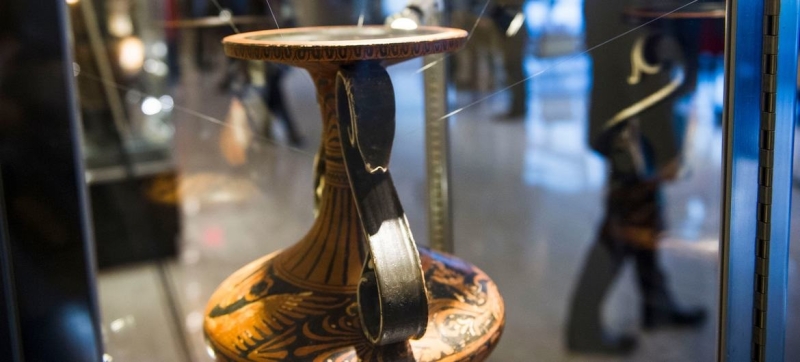- 8 Islamic parties want referendum before polls, neutral admin |
- Stocks sink on week’s last trading day; DSEX plunges 122 points |
- Former Sramik Dal leader shot dead in Chattogram |
- Trump Ends Historic US Shutdown After 43-Day Standoff |
- Dhaka’s air quality ‘very unhealthy’ on Friday morning |
Global Fight Intensifies Against Illicit Antiquities Trade

An artifact is displayed at an exhibition at UN Headquarters focused on protecting cultural heritage.
The illicit trade in cultural property is one of the world’s oldest and most profitable forms of criminal activity. However, efforts by the UN and law enforcement agencies worldwide are increasingly disrupting these operations.
Last year alone, more than 37,000 cultural objects – including archaeological artifacts, works of art, coins, and musical instruments – were seized during an international operation by Interpol and other organizations, in coordination with law enforcement and customs authorities from 23 countries.
In Ukraine, customs authorities intercepted 87 historically valuable items, including icons of Saint Seraphim of Sarov and ancient coins that smugglers tried to illegally export to Poland, Moldova, and Romania. In Spain, investigators uncovered a group that looted archaeological sites in Cáceres, using metal detectors to extract thousands of Roman coins and sell them through social media. In Greece, three individuals were arrested for attempting to sell five Byzantine icons for $80,000.
International Cooperation
According to the UN Office on Drugs and Crime (UNODC), the smuggling of cultural property ranks alongside arms and drug trafficking as one of the most profitable illicit trades. Unlike other forms of trafficking, however, cultural property trade is not outright prohibited.
High demand for antiquities and artworks, combined with weak regulation, makes the market highly lucrative and relatively low risk, especially during political instability, war, and social upheaval when archaeological sites and museums are left unguarded. Organised criminal networks exploit crises, operating through complex supply chains and profiting from both legal and black markets.
Speaking ahead of the International Day Against Illicit Trafficking in Cultural Property on 14 November, UNESCO’s Krista Pikkat said, “Illicit trafficking and thefts of cultural property affect cultural rights, identity, memory, and communities’ history.”
Traffickers increasingly use online platforms and auctions to sell stolen items, including objects recovered from underwater archaeological sites. UNESCO condemned the October 2025 theft of “eight priceless cultural objects” from the Louvre in Paris, warning that such crimes “jeopardise the conservation, study, and transmission of valuable historical artefacts.”
Terrorism Financing
Illicit trafficking also fuels criminal networks linked to money laundering, tax evasion, and even terrorism financing. Since 2023, UNESCO has trained over 1,200 museum and customs professionals from 80 countries to strengthen legal frameworks, enhance skills, and raise public awareness.
“We’re collaborating with partners like the IAEA to explore how nuclear technology can aid provenance research,” Ms. Pikkat added. “AI and new technologies also provide fresh opportunities in the fight against illicit trafficking.”
In September, UNESCO launched the world’s first Virtual Museum of Stolen Cultural Objects, using 3D modeling and virtual reality to display digital replicas. The platform includes educational materials, community testimonies, and examples of successful restitutions. “The idea is that one day it will be empty,” Ms. Pikkat said.
She highlighted Estonia’s contribution of 16th-century altar sculptures, crafted by Lübeck artisans, reflecting its historical ties to the Hanseatic League. UNESCO emphasizes that the true value of artifacts lies in their historical, cultural, and spiritual significance.
Digital tools such as electronic registries, databases, and blockchain technology now assist in tracing antiquities’ provenance. Authorities urge buyers to always request official documentation and report suspicious items to law enforcement or Interpol. Each repatriated artifact restores a vital link between past and present.

